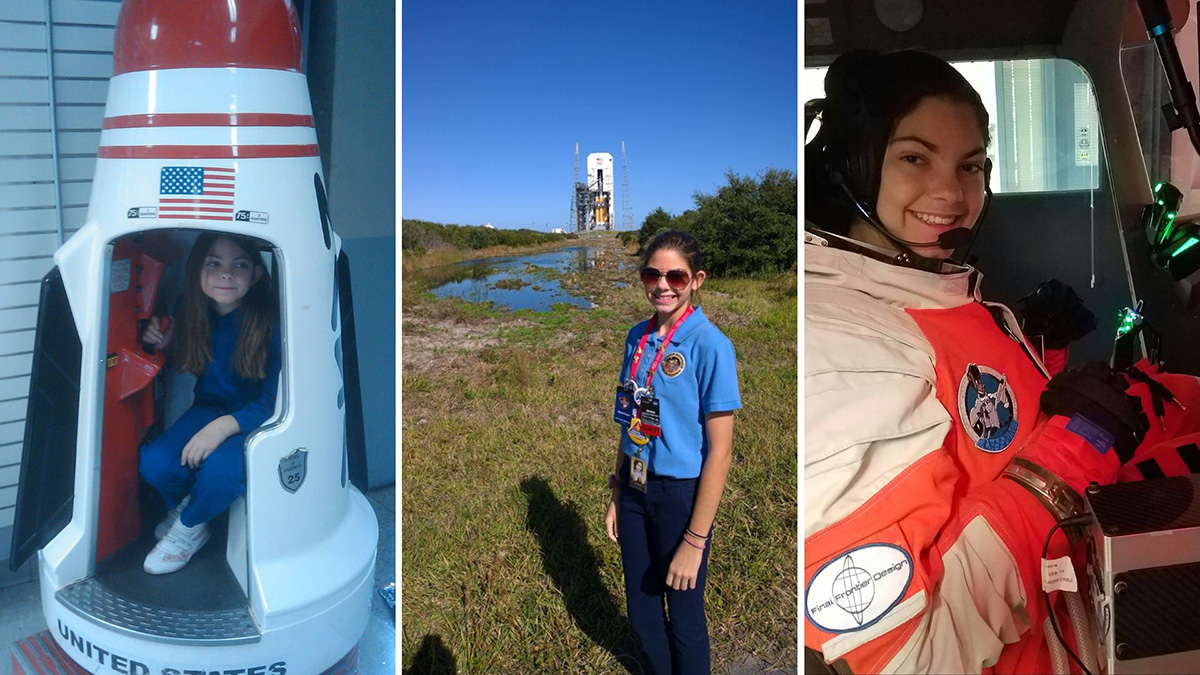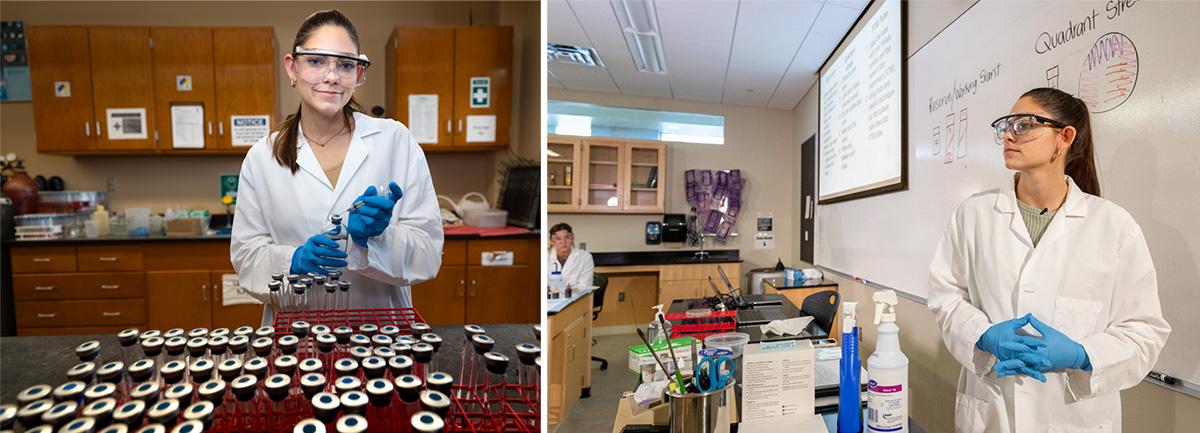
EMBRACING THE UNKNOWN
Alyssa Carson yearns to venture into space and explore the unknown. She’s slowly building her resume as a potential astronaut, and as a doctoral student at the University of Arkansas, she’s honing her skills in the field of astrobiology. She’s garnered thousands of followers on social media while attending every space camp offered by NASA and working to make a career out of studying the cosmos.
“I think it’s so important that we continue to pursue and learn more things about space,” she says. “And I just want to be a part of it in some capacity.”
Carson, originally from Louisiana, earned her undergraduate degree in astrobiology from Florida Tech. While searching for a graduate school, she was encouraged to pick one based on its research – particularly research that she would be interested in pursuing herself. And when she read more about what was happening in Arkansas, she reached out to Tim Kral, a professor in the Department of Biological Sciences, whose work in astrobiology caught her eye.

 I think the University of Arkansas plays a huge role in my career goals,” Carson
says. “I was really lucky to find a professor and research at the U of A that I’m
passionate about and excited to pursue.
I think the University of Arkansas plays a huge role in my career goals,” Carson
says. “I was really lucky to find a professor and research at the U of A that I’m
passionate about and excited to pursue.
BLUEBERRY BEGINNINGS
At seven or eight years old, Carson attended her first space camp in Huntsville, Alabama – a family camp that she experienced with her dad.
“Space camp was basically my equivalent of Disney World as a kid, because it was everything that I was obsessed with,” she says. “I was learning all the information I was so eager to know about and doing simulators and simulated missions. Space camp became like a second home to me, and I kept going every year for the rest of my childhood.”

Over the years, Carson attended 19 camps in three countries and was nicknamed “Blueberry” – a nod to the blue flight suits that she wore.
“It’s like a call sign – kind of like a nickname, but it has to be given to you,” she explains. “When I was going to space camp as a kid, I wanted one of the blue flight suits that I saw everyone wearing. My dad ended up finding this knockoff flight suit that was a really dark shade of blue and just completely different from everyone else’s. And so they just started saying, ‘You look like a blueberry wearing it.’”
The name stuck, and year after year, Carson would hear, “Oh, Blueberry is back!”
As she’s developed her interests, Carson’s own love for space, science and math has inspired her to encourage other kids – particularly girls – to consider careers in STEM. Her social media feed is filled with posts about her love for space, as well as behind the scenes shots of the real work she is doing to pursue her own dreams.
Alyssa’s Favorite...
- Role model: Sandra Magnus
- Space movie: “Contact”
- Planet: Mars
- Subject in school: Math
- Spot on campus: CORD Courtyard
“There were a lot of other women surrounding me when I was first getting started,” she says. “Being able to not only show up in person and speak to young kids but also show them on social media is a huge step in helping them realize they can really pursue whatever their dreams may be.”
SPACE ON THE HILL
Research at the university’s Center for Space and Planetary Sciences is paramount. Students operate in an academic setting with the freedom to explore what interests them. This approach has resulted in the center becoming a training ground for the next generation of NASA hopefuls and garnering an impressive track record – roughly half of all graduates from the associated master’s and doctoral programs have moved on to the agency itself, a NASA-related research facility or a private corporation with a NASA contract.
Because the research they’re conducting at the U of A isn’t done in a mission-driven NASA lab, it gives students the flexibility to explore fundamental questions. And when they get to NASA, their ideas circulate. In this regard, space and planetary research at the U of A influences research missions at the agency.
“The topic or the work students did for their Ph.D. could be something entirely new to NASA methods,” says Vincent Chevrier, research associate professor at the center. “So, in some ways that can be seen as a service. The students and the university indirectly are informing a research agenda at NASA. NASA doesn’t take our research projects, but we provide students who arecompetent research scientists who work on the projects NASA is developing. We are creating a new generation of NASA research scientists and probably the people who are going to be involved in developing missions.”

Four of the five most recent doctoral alumni from the program – all women – work at NASA: two at the Goddard Space Flight Center, one at Glenn Research Center and one at the famous Jet Propulsion Laboratory in Pasadena, California.
Since 2008, Chevrier and his students have worked on several major projects, some of which have guided or influenced NASA missions. Even before NASA confirmed the presence of liquid water on Mars in September 2015, he and other researchers at the center had been analyzing experimental data related to the possible existence of liquid water on the Red Planet. Much of their work since that time has focused on this discovery, expanding it to explore the possibility of viable life on Mars.

In addition to Mars, Chevrier and his students have received funding to study the atmosphere of Venus; ice, lakes and liquid hydrocarbrons on Titan (Saturn’s largest satellite and the second-largest moon in our solar system); and ices on Pluto.
MARTIAN MUSINGS
Like Chevrier, Carson’s research with Dr. Kral also centers on Mars – and whether certain types of bacteria can survive and grow in the planet’s atmosphere. Their work is aligned closely with the Department of Biological Sciences.
The Mars simulation chamber is one of six housed on the university’s campus. The Andromeda chamber, acquired from NASA’s Jet Propulsion Laboratory, was the first one acquired by the U of A, and is a vital part of the W.M. Keck Laboratory for Planetary Simulations, which opened in 2004. Additional chambers include one for Venus, two for Mars, one for Titan and two simulating outer regions of the solar system.
Inside these tanks, researchers build micro worlds that enable them to explore big questions, including why one planet is uninhabitable while its virtual twin has all manner of biotic life. They have investigated what Earth was like before the atmosphere contained oxygen, and whether liquid water could exist in a place where it rarely gets above freezing. Researchers study chemical and physical conditions at the surface of planets, how the surface of planets evolved over time, how they interacted with their atmosphere when it was present, and – like Carson – what could potentially survive and grow.
“We use the Mars chamber to simulate Martian pressures,” Carson explains. ”Recently, we mixed bacteria with a growth medium and potential minerals or clays and put those test tubes in the chamber for a set period. Then we can take a sample of the air and test it for methane. If there’s methane, they’ve survived. We’re working with four different species of bacteria, and we’re also examining whether anything happens to the minerals in the tubes because of the bacteria.”

Although this research targets Mars and space, it’s still connected to everyday life on Earth.
“Some of the different methods that we use and develop to do this kind of testing can also be used in different applications,” she explains. “We’ve always been fascinated at the idea of life out there – if it’s possible, what it means.”
After Carson finishes her doctoral degree, she’ll keep an eye out for openings in NASA’s astronaut selection process. If their search includes applicants with skills in astrobiology, she’ll be a strong candidate.
 “If I had the opportunity to go to space, I would be beyond thrilled,” she says.
“It’s such a unique and special place.”
“If I had the opportunity to go to space, I would be beyond thrilled,” she says.
“It’s such a unique and special place.”
Watch “Short Takes: Give Her Space” for more on Alyssa Carson